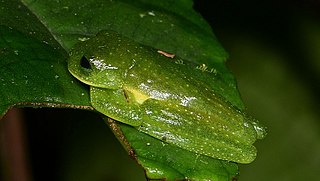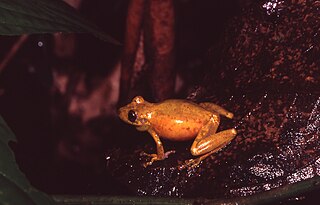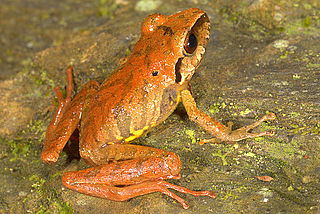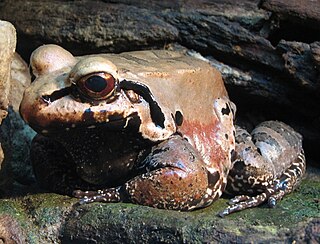
Centrolene ballux is a species of frog in the family Centrolenidae. It is known from a few disjunct localities on the Pacific versant of the Cordillera Occidental in southern Colombia and northern Ecuador. Common names golden-flecked glassfrog and Burrowes' giant glass frog have been coined for it.
Callimedusa ecuatoriana is a species of frog in the subfamily Phyllomedusinae. It is endemic to Ecuador and known from the Amazonian slopes of the Andes in the Morona-Santiago Province as well as from Cordillera del Condor in the Zamora-Chinchipe Province. Common name Agua Rica leaf frog has been proposed for it.
Plectrohyla pokomchi is a species of frogs in the family Hylidae. It is endemic to central and eastern Guatemala and known from Sierra de Xucaneb and Sierra de las Minas at elevations of 1,400–1,900 m (4,600–6,200 ft) above sea level. Its specific name refers to the Poqomchi' people, a group of Indian people from the Guatemalan highlands. Common name Rio Sananja spikethumb frog has been coined for it.
Quilticohyla acrochorda, commonly known as the warty mountain stream frog, is a species of frogs in the family Hylidae. It is endemic to Mexico and known from the Atlantic slopes of the Sierra Juárez in Oaxaca. Before being described as a new species in 2000, it was mixed with Ptychohyla erythromma. The specific name acrochorda is a Greek word for "wart" and refers to the distinctive white warts on the posterior surface of the thigh of this frog.

Scinax cruentomma is a species of frog in the family Hylidae. It is found in the upper Amazon Basin of southern Colombia, eastern Ecuador, northeastern and east-central Peru, and western Brazil; its presence is French Guiana is dispted. The specific name cruentomma is derived from the Greek cruentos meaning "bloody" and omma meaning "eye", referring to the red streak in the eye of this frog. This species is also known as the Manaus snouted treefrog.
Pristimantis ceuthospilus is a species of frog in the family Strabomantidae. It is endemic to northern Peru and occurs on the western slopes of the Cordillera de Huancabamba and the Pacific slope of the Cordillera Occidental. There are also as yet unconfirmed records from southern Ecuador. The specific name ceuthospilus, from Greek keuthos ("hidden") and spilos ("spot"), refers to the yellow spots in the groin and thighs that remain hidden when the frog is sitting. Common name Wild's robber frog has been coined for it.

Pristimantis danae is a species of frog in the family Strabomantidae, sometimes known as Cuzco robber frog. It is found in the Andes between southern Peru and north-western Bolivia. It is named after the daughter of the author, Dana K. Duellman, who helped in collecting the frogs. Pristimantis reichlei, described in 2009, was previously confused with Pristimantis danae.
Niceforonia dolops is a species of frog in the family Strabomantidae. It is found in the Andes of southern Colombia and northern Ecuador. Specifically, it is known from the Cordillera Oriental and Colombian Massif in Caquetá and Putumayo Departments, Colombia, and Napo Province, Ecuador. Common name Putumayo robber frog has been coined for it.
Pristimantis quaquaversus is a species of frog in the family Strabomantidae. It is found on the lower Amazonian slopes of the Andes from northern Ecuador south to the Cordillera de Cutucú and Cordillera del Cóndor as well as the adjacent northern Peru.
Pristimantis vertebralis is a species of frog in the family Strabomantidae. It is endemic to the Andes of Ecuador and occurs in the Carchi, Imbabura, Pichincha, Cotopaxi, Bolívar, and Azuay provinces. Common name vertebral robber frog has been coined for it.
Oreobates zongoensis is a species of frog in the family Strabomantidae. It is endemic to Bolivia from Valle del Zongo, in Pedro Domingo Murillo Province.
Gastrotheca ochoai is a species of frog in the family Hemiphractidae. It is endemic to southern Peru and occurs in the interandean valleys on the eastern face of the Andes. The specific name ochoai honors Oscar Ochoa Mendieta, a biology professor from the National University of Saint Anthony the Abbot in Cuzco who helped the species descriptors during the field work. Common name Chilca marsupial frog has been coined for this species.

The smoky jungle frog is a species of frog in the family Leptodactylidae. It is found in Bolivia, Brazil, Colombia, Ecuador, Costa Rica, Panama, French Guiana, and Peru. Its natural habitats are tropical and subtropical moist broadleaf forests, subtropical or tropical swamps, subtropical or tropical moist montane forest, rivers, freshwater marshes, intermittent freshwater marshes, and aquaculture ponds.

Lynchius flavomaculatus, also known as the yellow-spotted Andes frog, is a species of frog in the family Strabomantidae. It is found in the Andes of southern Ecuador and northern Peru.
Niceforonia lucida is a species of frog in the family Strabomantidae. It is endemic to Peru and known from the Cordillera Central west of the Apurímac River in the Ayacucho Region. Common name Cannatella's Andes frog has been coined for it. The specific name lucida refers to distinctive coloration of this frog relative to frogs in the genus Phrynopus, the genus where this species was initially placed. However, later studies have moved it to other genera where its colors are less distinctive.
Lynchius nebulanastes is a species of frog in the family Strabomantidae. It is endemic to north-western Peru where it is known from the vicinity of its type locality, El Tambo, on the western slope of the Cordillera de Huancabamba, Piura Region. Common name Canchaque Andes frog has been coined for it.

Engystomops petersi is a species of frog in the family Leptodactylidae. It is found in Amazonian Colombia, Ecuador, and Peru. It is morphologically similar to its sibling species, Engystomops freibergi, and for a period the latter was considered to be a junior synonym of Engystomops petersi. Taxonomy and classification of this species is constantly changing due to the continual evolution of behavioral isolation and rapid speciation in the region. There are also records from the Guianas that have not yet been allocated to either species. Divergence of these two species seems to have been driven by behavioural isolation related to male call characteristics more than geographic isolation.
Engystomops pustulatus is a species of frog in the family Leptodactylidae. It is known with certainty from western Ecuador, whereas the status of Peruvian records is ambiguous as they may refer to an undescribed species or possibly Engystomops puyango. Nevertheless, given that E. pustulatus is now known from Huaquillas in southern Ecuador, near the Peruvian border, it is likely to be found in Peru too.

Hamptophryne boliviana, also known as the Bolivian bleating frog or Amazon sheep frog, is a species of frogs in the family Microhylidae. It is found in the northern and western sides of the Amazon basin in Bolivia, Brazil, Colombia, Ecuador, French Guiana, Guyana, Peru, Suriname, and Venezuela. Genetic analysis suggests hidden diversity within the nominal species.

Raorchestes coonoorensis, also known as the Coonore bushfrog or Coonoor bush frog, is a species of frogs endemic to the Western Ghats, India. It is reported from its type locality, Sim's Park in Coonoor, with an additional observation from Kothagiri; both locations are in the state of Tamil Nadu. Its altitudinal range is 1,780–1,850 m (5,840–6,070 ft) asl.









